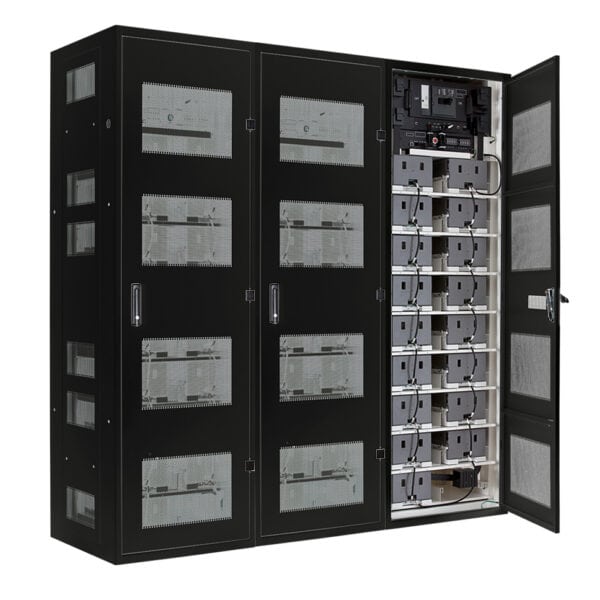UPS battery systems perform a vital role during mains power interruptions, but the choice of configuration could potentially lead to single points of failure. By using multiple strings of parallel batteries, and different interconnections between batteries and parallel UPS modules, each user can strike his own best balance between redundancy, resilience, cost and space.
UPS battery subsystems are typically configured as single strings for simplicity and cost reduction, yet create a potential single point of failure during a mains interruption. Multiple, parallel battery strings can solve this but are more expensive. Users can tune their battery string configuration and interconnection with parallel UPS modules to achieve the best cost/redundancy trade-off for their particular needs.
A ‘single’ or ‘serial’ string has identical battery blocks wired in series. A typical string would have 32 12V 76AH batteries providing a d.c. bus voltage of 384V and a 76Ah capacity. Although normally the most cost effective, this solution has no redundancy as one battery failure will disable the whole string.
A ‘parallel’ string comprises identical serial strings connected in parallel across the UPS battery input. A typical configuration could have three serial strings, each with twelve 32 12V 40AH batteries, providing the UPS with 384V and a 120Ah capacity. The extra batteries cost more than the single string, but provide longer battery autonomy during a mains failure. Additionally resilience is created because a single battery failure will not totally deprive the load of battery backup.
In mission critical applications where cost is a secondary consideration, each parallel UPS module warrants its own, separately fused, paralleled battery configuration. If space restrictions do apply, solutions such as more strings of lower capacity batteries can be used. Note that a single string of larger batteries is usually cheaper than multiple strings of smaller batteries.
If a multi module parallel UPS system is configured with a single battery string per module, a mains failure will immediately threaten the system’s ability to support the critical load. The severity of the threat is higher for capacity mode than for redundant mode systems. If each redundant UPS system module has dual parallel battery strings, UPS redundancy will be maintained even with a single battery failure. Appropriate rating of batteries will maintain battery autonomy. Transition boxes, used for battery fusing and cable termination, provide further protection and isolation for parallel UPS systems.
If cost and space restrictions exist in parallel UPS installations, these can be alleviated by using a common battery configuration, with all batteries shared by all the UPSs in the system across a common DC busbar. In terms of risk analysis the probability of a solid copper busbar failing is negligible so the choice of a common battery configuration is a prudent consideration.
Of course the optimum battery configuration for each installation depends on a number of factors, such as space, priorities of budget and load criticality. A good UPS supplier will be able to assist users to achieve a solution best matched to their particular circumstances.


